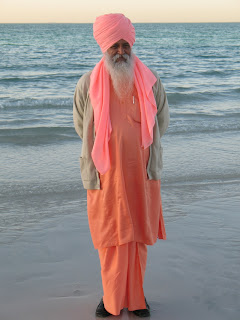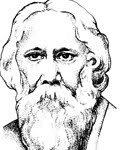
 A TRIBUTE
A TRIBUTEtoday, the may 25, is the first death anniversary of
sant ramanand who got fatally injured in a shoot out on may 24 at a
gurudwara in
vienna, the capital city of
austria and died late in the night. it was a mindless and brutal assassination of the
sant by some the fanatics.
sant ramanand's killing, in the violence, was a tragedy not only for the entire
punjabi community but also equally to the all embracing
sikh community. it was all the more painful as
sant ramanand himself was a great follower and preacher of the
guruvani, enshrined in the
sri guru
granth sahib. he understood the tenants of religion and more so of the
sikh faith of guru
nanak and guru
gobind singh along with that of guru
ravidass whose
vani is an important and integral part of the great
granth.
sant ramanand was an enlightened, spiritual and social personality. he was highly respected and revered by the society at large particularly the
dalits and other less privileged not only in
punjab but also else where in
india and abroad. he was a simple soul with an added flare for making people at ease and comfortable in his interaction with them. he was easily approachable. he has the ability to provided much needed spiritual and moral solace to the followers in these days of strife and conflict. the
guruvani came to him naturally in its recital, narration and even singing to the utter contentment of the large audiences which he used to have at various congregations at the
dera sachkhand ballan and else where. the content and focus of his message was to attain self contentment and awareness of social and spiritual needs of the society in general and particularly of the
dalits as a true follower of guru
ravidass and the guru's philosophy of lofty ideals of equality and fraternity. with the concerted efforts of
sant ramanand, the
dera sachkhand ballan became an epic centre of social and spiritual awakening among the
dalits to enable them to join the main stream of the society.
sant ramanand's stand alone contribution in this regard was immense. he was instrumental in promoting and spreading the message of guru
ravidass and mission of
dr. b.r.
ambedkar for uplifting the down trodden and suppressed segments of the society.
sant ramanand was the first to realise the comparatively growing economic and financial standing of the
dalit NRIs of
punjab and the role they could play in the empowerment of their families back home. he started to explore these opportunities and visiting foreign countries along with the chief - गद्दी नशीन -
sant of the
dera sachkhand ballan to start with the
uk. it will not be out of place to mention, as i personally know, that in the initial days, more than two decades before,
shri swaran bangar of the
uk and
shri d.c.
kumar of new
delhi ( both the close followers of the
dera and belonging to the village
ballan) played an important role and extended all possible help and assistance to
sant garib dass and
sant ramanand and facilitated their visits to the
uk and other countries.
the efforts of
sant ramnand and his total dedication to the cause of social and spiritual empowerment of
dalits, under the patronage and blessings of the
dera chiefs from
sant sarwan dass,
sant hari dass,
sant garib dass to the current chief
sant niranjan dass, made the
dera sachkhand ballan an established centre of these affirmative actions and activities. it is a matter of gratification that the
dera runs a number of educational and health institutions in
punjab and also spiritual and charitable trusts. under the patronage and direction of
sant garib dass,
sant ramanand contributed greatly in bringing ' seer
goverdhanpur ' (
kanshi -
varanasi), the birth place of guru
ravidass on the national and international map as a holy place of pilgrimage for the followers of guru
ravidass. it is very much appreciable and
praiseworthy.
sant ramanand was
instrumental in promoting the mission of guru
ravidass through the print and electronic media by publishing books, bringing out
dvds and launching a weekly paper '
begumpur Shaher'. it was not an easy job. the impact of it is visible with the songs like ' सारे कर लओ एक़ा, बेगुम्पुरा वसौनां आं ! ' ranting the air of
punjab. the greatest
contribution of
sant ramanand, to my mind, is that during his life time he succeeded in bringing about much needed awareness of the hidden potential among the
dalits to stand up and face the challenges of life and live a dignified life. it is a matter of great
satisfaction, of late, the community is getting empowered
increasingly. but still much remains to be done.
coming to my personal association and interaction, i have had the honour to meet and know
sant ramanand. though, due to my service conditions, i remained out of
india most of the time yet we in the family remained connected with the
dera sachkhand ballan both for social and spiritual needs. i met
sant ramanand at our home when he came with
sant garib dass at the'
bhog ' ceremony of my father
shri sodhi ram's death in
april, 1986.
sant ramanand led the
kirtan of
guruvani. the
sabad of guru
ravidass ' जल की भीत पवन तू थुम्बा, रक्त बूंद का गारा ' sung by him still echos in my ears. i could not control my emotions and wept like a child.
sant ramanand had the ability and capacity to sway the audiences at such functions. my second encounter with
sant ramanand was yet another kindness of
sant garib dass in the summer of 1989.
sant garib dass was not well and was admitted to a hospital in
delhi. i went to see him with my brother in law d.c.kumar. we requested
sant garib dass to bless us at our apartment in
pitampura after the release from the hospital. he very kindly agreed and visited us with
sant ramnand. after talking to them over a frugal lunch, i realised that both the
sant had a special corner in their hearts for the upcoming ( if i could join that category) members of the community. they humbled me further.
sant ramanand and
sant niranjan dass visited us at our flat in
kalkaji in
delhi in 1999. they were in transit in
delhi for one of their trips abroad. we spoke at length on many issues of interest and concern pertaining to the community. i tended to be frank but with total respect and regard.
sant ramanand was sharp and quick to knew my mind.
sant niranjan dass is an embodiment of simplicity. while getting up and leaving, he enquired, whether i consume alcohol. on my affirmative answer,
sant niranjan dass advised, in a saintly tone and manner, that i shall not do so and added, in a child like simplicity, that you have a great
responsibility and some vested interests could make you sign certain things under the influence of intoxicants.
sant ramanand saved the situation and moderated by saying that there was nothing to worry as i knew it well. i said that i would be careful. but, to be truthful, i still like a drink or two. my last meeting and interaction with
sant ramanand alongwith sant niranjan dass happened in
vienna in the autumn of 2006. i was posted in
prague and was on a private visit to
vienna. i came to know that the
sants were also in vienna. i spoke to them on phone and requested for a brief meeting, if poosible, whereever they were staying. sant ramanand was kind enough to suggest that they would like to come to me rather i go to them. it was an honour. they came to the residence of my brother in law hussan lal where i was putting up. my respect for them was further strengthened. it provided me yet another close opportunity to discuss matters of mutual interest. i recognised and appreciated the good work being done by the dera sachkhand ballan particularly by sant ramanand. i suggested that it will be appropriate if an opportunity could be explored and created for sant ramanad to participate at one of the international inter-faith conferences/dialogues with view to provide exposure to the work and mission of the dera sachkhand ballan. sant was appreciative of the suggestion and instructed one of his associates to make note of the suggestion. i also spoke my mind and concern about the security and the time schedule of the sants. i reiterated that, with growing involvement of the dera and personally of the sants in various social and spiritual activities of the community, it is important to take care of these aspects. the vested interests were bound to get envious and and might develope hostility towards our interests. it was also equally important to be careful of some of the self styled leaders of the community who might hijack the agenda for their own purposes. i said that some regulation and proper monitoring was needed. i felt that sant ramanand was not oblivious of these requirements. but it appeared that he was the man in a hurry to complete the agenda and, to his mind, an open and flexible approach was more functional to achieve early results. unfortunately, it worked the other way and proved tragic.
all said and done, the community is on the cross roads again. the anguish and pain felt by the dalit community, in the removal of sant ramanand by force of the gun by the radicals, was visible in the after math of the vienna tragedy of may 24-25, 2009. the timely action and damage control measures taken by the authorities saved the situation and from further injury to the social fabric of the society. the dalit community has started, as rightly wished by the sant, asserting its identity to find due and dignified space in the society. in a recent write-up in the tribune, shri vinod sumbly, commenting on these matters, rightly wrote ' it marks the beginning of a new era when those at the bottom of the ladder have dared to ascend to the top.' sant ramanand's great contribution in bringing about this much needed change should be noted and recorded with gratitute, it will make a befitting tribute to the memory of the great sant. the awareness and energy generated by sant ramanand and the dera sachkhand ballan and all others concerned should be identified, channelised and exploited to the greater good and empowerment of the community. it would be another tragedy, if the positive and affirmative energy is wasted mindlessly with half waked ideas and directionless strategy. the need of the hour, to my mind, is to think and act with a pragmatic approach and to ward off the possibility of hijacking the agenda and the mission by some vested interests for their own selfish designs. the following couplet says the thinking of sant ramanand:
तू पहले बात फिर बात का अंदाज पैदा कर;
फिर जमाने में तुजे कोई नज़र अंदाज कर नहीं सकता !









